#I think it’s also a kind of narrative that’s commonly used for ‘brothers in arms’-type characters
Text
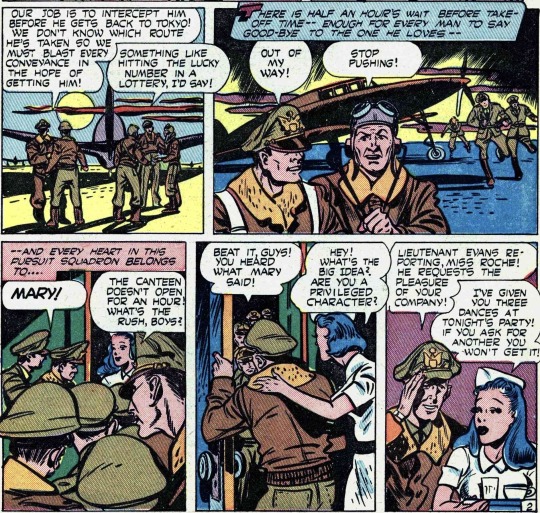



Contact Comics (1944) #2
#I’m intrigued by the gender politics of this#as Black Venus this character is essentially taking on the role of an official pilot#while her tracking down the body of this pilot and then vowing revenge for his death has a romance framing#I think it’s also a kind of narrative that’s commonly used for ‘brothers in arms’-type characters#her competence as a pilot also wasn’t questioned in last issue’s story by the other characters#and there and here it’s not being remarked upon that she flies well for a woman in the narration#I like that Black Venus cries when she finds the body and then directs those feelings into#‘I’ll get him for this- I’ll kill him if it’s the last thing I do!’#also the Agent X that murdered the pilot is revealed to be a woman#when Black Venus learns this she’s really startled#and Agent X says ‘Don’t let that deceive you! I can still defeat you!’#she does not actually as Black Venus succeeds in murdering her#also it seemed to me that this pilot was not the same primary love interest from the first story that stood out from all the other pilots#so I was thinking that Black Venus' civilian job as a U.S.O. girl would give her a revolving door of love interests#but then at the end of this story she dramatically declares that because of this pilot’s death#‘From now on no matter how many people are around me I will always be alone!’#/if/ they actually maintain that she’s swearing off romance then that would be an interesting conflict with her job#aviation press#black venus#my posts#comic panels#racist language tw
3 notes
·
View notes
Text
Winterfell’s Daughter. On Sansa Stark (part 15)
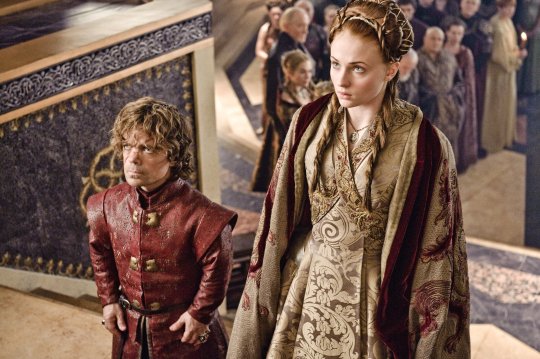
I’ve previously written a series of essays that analyse Sansa Stark’s narrative arc in Game of Thrones - during season 1 (Part 1, Part 2, Part 3, Part 4, Part 5, Part 6) and during season 2 (Part 7, Part 8, Part 9, Part 10) and now during season 3 (Part 11, Part 12, Part 13, Part 14).
As I’ve repeatedly stated, Sansa’s season 3 arc revolves around her political importance as Robb Stark’s heir apparent since her younger brothers Bran and Rickon are dead in the eyes of Westeros. Several major power players attempt to secure Sansa in order to control her claim to the North but it is the Lannisters who win that political game by wedding her to Tyrion after Petyr Baelish revealed the secret plan of the Tyrells to marry Sansa to Ser Loras. In this post, I’m going to take a closer look at how the wedding between Sansa and Tyrion plays out in episode 8.
BEFORE THE WEDDING
In my previous post, I criticized the manner in which the show frames Sansa’s reaction to the fact that she is forced to marry Tyrion Lannister - a marriage designed to exploit her status as Robb’s heir, a marriage predicated upon a plot to murder her brother and his pregnant wife so that Sansa will become the Key to the North in truth. It is a diabolical plan when you really think about it but the show mainly presents this whole thing from Tyrion’s perspective and when we are shown Sansa’s reactions, they are framed as shallow and intolerant (i.e. she’s not attracted to Tyrion because he’s a dwarf). The fact that she’s the victim in this scheme is effectively glossed over in episode 7 when Margaery attempts to console her.
Fortunately, the show turns out to be rather inconsistent in terms of how it frames Sansa’s reaction to this marriage in episode 8 where Tyrion comes to see her before the ceremony. The scene starts with a close-up of Sansa’s doll, the one that Ned gave her after he killed Lady. This doll may have functioned as a symbol of Ned’s guilt (x) and a reminder of Lady’s death in the beginning but after his death, it has come to mean something else for Sansa. Now it is the last tangible link to her father as well as a source of comfort to her (x). It is also a visual reminder to the audience that Sansa is still a child – and too young to get married! This is something that the show also explicitly states – both Shae and Tyrion call her a child within the context of marriage and sex, which really drives home how callous Tywin Lannister is in his exploitation of her claim to the North.
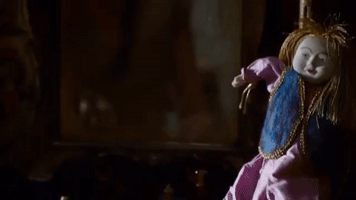
After the close-up of the doll, the camera pans up and we see that the doll is placed on Sansa’s dressing table, next to the mirror wherein we see her reflection as her maids prepare her for her wedding. There’s a knock on the door and Tyrion enters the room, his reflection joining Sansa’s in the mirror. Sansa stands up to greet her intended while Shae remains at her side.
Sansa: You look very handsome, my lord.
Tyrion (sarcastically): Oh, yes. The husband of your dreams. But you do look glorious.
Sansa fidgets, wringing her hands nervously as Tyrion asks for a moment alone with her. The conversation that follows is very awkward, mostly because Tyrion repeatedly says the wrong things, then realizing his blunders and trying to backtrack.
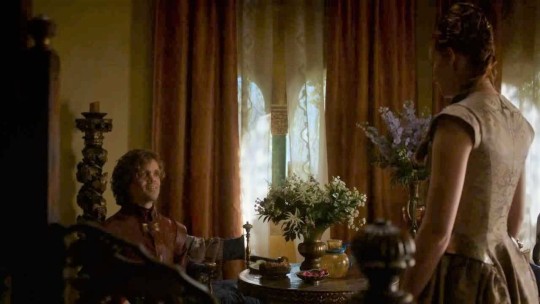
Tyrion: My lady, I want you to know. I didn’t ask for this.
Sansa (tonelessly): I hope I will not disappoint you, my lord.
Tyrion: No, don’t. You don’t have to speak to me as a prisoner. You won’t be a prisoner after today. You’ll be my wife.
This is a rather tactless utterance on Tyrion’s part. The fact remains that Sansa IS a prisoner – and the marriage is designed to keep her a permanent one. Tyrion may not have asked for this marriage but Sansa never gave her consent and she isn’t in a position to refuse. This is a FORCED marriage and she is not obligated to try to make the best of it or relieve Tyrion of his unease. However, she doesn’t dare to express her displeasure. Instead we see Sansa utilizing her trademark courtesy as a piece of emotional armour, keeping up a wall of icy politeness to keep Tyrion at arm’s length.
Tyrion: I suppose that is a different kind of prison.
So he does understand but then he immediately tries to forge a connection in another way, only to fail again.
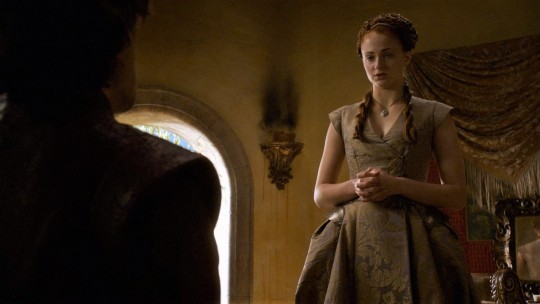
Tyrion: I just wanted to say… I’m just trying to say, very badly… I just… Just want to say I know how you feel.
This is just incredibly presumptuous of him. While he didn’t ask for the marriage, his feelings cannot be compared to Sansa’s. Her hopes for freedom have been crushed and she can only look forward to a lifelong imprisonment as the Lannisters attempt to steal her home. Tyrion is trying to make himself feel better because he knows that this marriage is designed to disenfranchise her while it is set up to benefit him. Thankfully, Sansa refuses to play along here.
Sansa: I doubt that very much my lord.
Tyrion: You’re right. I have no idea how you feel. And you have no idea how I feel.
It is clear that Sansa’s impassive demeanour makes Tyrion very uncomfortable, which makes him defensive. However, he is also very much aware of how wrong it is of Tywin to force Sansa into this marriage and he’s trying to make himself feel a bit better about the role he is to play in this farce.
The camera cuts to a close-up of Tyrion taking Sansa’s hand.

Tyrion: But I promise you one thing, my lady. I won’t ever hurt you.
Finally, Tyrion strikes the right chord. He ought simply to have lead with an acknowledgement that she doesn’t want this marriage but that he’ll never hurt her. He takes her arm and they leave her chambers. Then the camera cuts to an exterior view of the Sept of Baelor where the wedding ceremony is to take place.
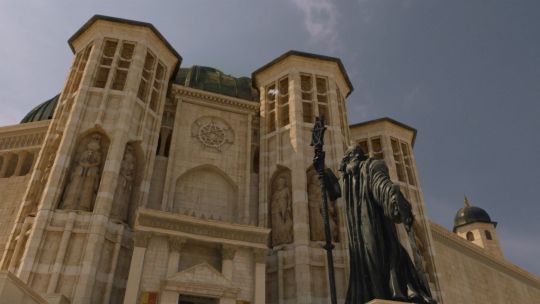
What is notable about this shot is the fact that the cinematographer uses a frog’s eye perspective (from below), which makes the building loom threateningly over the spectator. This is a good example of how the camera work can be invested with emotion. The prospect of the wedding and the marriage is an oppressive threat for Sansa – so one can argue that the first view of the Sept of Baelor is set within her POV and the audience is invited to share it through the visual language.
THE CEREMONY
After a barbed conversation between Margaery and Cersei, the camera cuts to an exterior view of the doors to sept, shot from the frog’s eye perspective that lends the visuals an oppressive, even threatening quality. As the doors are slowly opening, Sansa walks into frame until she is framed by the door way.

Then the camera cuts to an OTS (over the shoulder) shot with Sansa framed by the light from the open doorway and a pair of septas.

She’s the visual focal point of this scene though the OTS shot locates the camera (and thus the eye of the audience) within Tyrion’s POV - since the OTS shot is a device often used to anchor a shot within the POV of a given character.
The camera gets to peek over the shoulder of our main talent and assumes a point of view like that of our talent. The camera (and therefore the viewing audience) sees directly what the main talent sees. Granted, the face of the actor is hidden from view, so we do not know what he or she may be thinking or feeling from this angle, but since the audience is placed into the shot from the character’s point-of-view (POV), the audience is encouraged to do the thinking and feeling for the character or as the character more directly. This is sort of an objective – subjective shot type where you get a privileged point of view from what is usually a more neutral camera angle. (x)
The OTS shot is followed by a close-up of Tyrion - this reaction shot also functions to make clear that we are dealing with Tyrion’s experience as Sansa enters the sept. We are still within his POV.

A reaction shot is one of the basic units of film grammar and it is used as part of the non-verbal story-telling in order to express the inner life of the characters:
A reaction shot usually implies the display of some sort of emotion on the face of the actor being shown, and is thus most commonly a close-up shot (although a group of actors may be shown reacting together). A reaction shot is also generally bereft of dialogue, though this is not an absolute rule. Its main purpose is to show an emotional response to the immediately preceding action or words of another character in the scene, or to an event in the immediately preceding scene which may or may not involve another actor (e.g., an explosion, monster, empty room, etc.) (x)
There are a lot of reaction shots in this scene as we see the various characters respond to what is happening - and since this is a fairly long scene with very little dialogue, these shots are quite important in order to lend the proceedings emotional intensity.
After Sansa has moved into the sept, Joffrey approaches her with a swagger and a smirk. He can hardly contain his glee because he’s using this event to torture her emotionally. He reminds her that her father is gone and since the King is the Father of the Realm, he’ll give her away to her husband-to-be. The fact that Joffrey, who is responsible for Ned Stark’s death, is going to act as proxy for Sansa’s father during the ceremony just underscores how much of a farce this wedding is.

Sansa reluctantly takes his arm and they begin to walk forward as the doors close behind them.
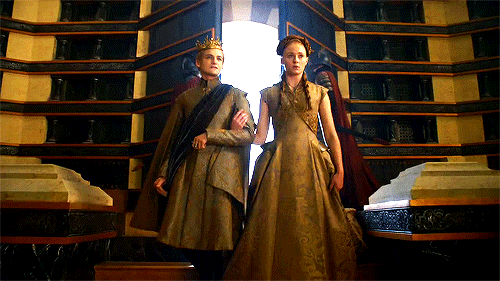
The walk up to the altar takes a fair bit of time - from the moment that Sansa enters the sept and until she stands at the altar - is about 1:30 min long. That is, in fact, a very very long in terms of cinema and television. The moment of her approach to the altar is dragged out to an almost uncomfortable degree - and this underscores the awkward and uncomfortable nature of the event.
Joffrey and Sansa ascend the stairs to the altar and as they come abreast with Tyrion, Joffrey takes away the little stool that Tyrion was to use for the cloaking of the bride. Because Joffrey is a little shit who likes to humiliate people, especially the two he seems to hate the most: Tyrion and Sansa.
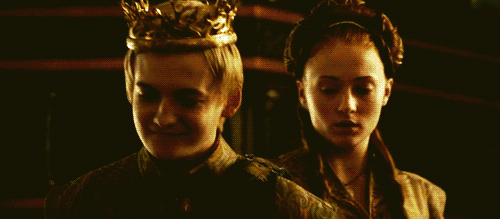
After this little piece of assholery from Joffrey, Sansa and Tyrion face the alter and the septon. Once again we get an OTS shot, this time from the septon’s POV. This shot is angled from a bird’s eye perspective (from above), which is the opposite of the frog’s eye perspective - but the effect is the same. This angle lends the scene an oppressive quality, which helps to convey how unhappy event this wedding is for both Sansa and Tyrion.

Septon: You may now cloak the bride and bring her under your protection.
Sansa turns her back on Tyrion so that he can put the Lannister cloak on her shoulders. However, Joffrey has removed the stool that was provided for this purpose. Tyrion shakes out the cloak and approaches Sansa. A wide-shot makes it clear that it is impossible for him to cloak her when she remains standing.
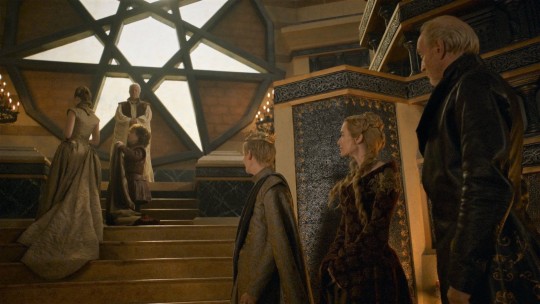
Sansa remains standing for quite a bit of time while Tyrion struggles with the cloak. In fact, she remains standing for 10 whole seconds, which is a LONG time in terms of television. Long enough for the crowd to begin laughing – in fact, the scene includes a number of reaction shot of various people laughing.
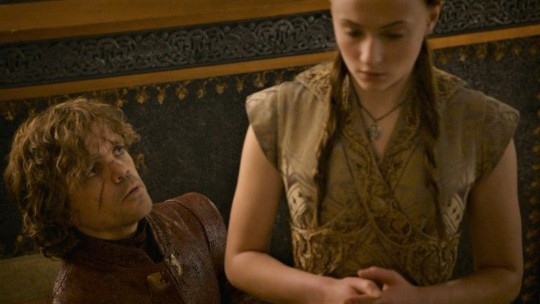
In the end, Tyrion has to ask Sansa to kneel, which she eventually does.

This scene is somewhat different than the way it is portrayed in the books where Sansa refuses to kneel for the cloaking ceremony and Tyrion eventually has to resort to use Ser Dontos as a stool.
The bride's cloak he held was huge and heavy, crimson velvet richly worked with lions and bordered with gold satin and rubies. No one had thought to bring a stool, however, and Tyrion stood a foot and a half shorter than his bride. As he moved behind her, Sansa felt a sharp tug on her skirt. He wants me to kneel, she realized, blushing. She was mortified. It was not supposed to be this way. She had dreamed of her wedding a thousand times, and always she had pictured how her betrothed would stand behind her tall and strong, sweep the cloak of his protection over her shoulders, and tenderly kiss her cheek as he leaned forward to fasten the clasp. She felt another tug at her skirt, more insistent. I won't. Why should I spare his feelings, when no one cares about mine? (ASoS, Sansa III)
The question is: Why did the show make this change? I suspect that this change was made for practical reasons. Having Peter Dinklage balance on the back of another actor while putting an unwieldy piece of fabric on Sophie Turner seems a bit unsafe for him. He could easily fall and hurt himself in such a scenario. So the way the scene played out may just have been a pragmatic solution to a practical problem in order to prevent a situation where an actor could possibly be injured.
Many fans were very upset with this change and so was I at first because it seemed as if the writes removed what little agency Sansa had left in this situation. However, upon a re-watch I have changed my stance on this issue. Once again, I want to point out that Sansa remaining standing for the duration of 10 seconds is almost an eternity in terms of cinema! The fact that Tyrion literally has to beg her to kneel does highlight that she is quietly refusing to make things easy for him because she is being forced into this marriage.
Her action is a piece of quiet resistance on her part but it is very subtle – so subtle that it is very easy to overlook unless you pay attention and think critically about the way that this scene plays out.
youtube
(The cloaking scene begins at timestamp 6:20)
After the cloaking, Tyrion and Sansa face the High Septon who proceeds with the ceremony. We get a close-up of Sansa with a downcast gaze as sighs audibly.

High Septon: We stand here in the sight of the Gods and to witness the union of man and wife. One flesh, one heart, one soul. Now and forever.
The scene ends here - and we don’t get to see the rest of the ceremony.
A CURIOUS OMISSION
Re-watching this scene, I noticed something odd. What is interesting here is the fact that the wedding ceremony doesn’t include the most important parts of the way that a wedding is conducted in the Light of the Seven:
The hand fasting.

The recitation of the wedding vows. (Father, Smith, Warrior, Mother, Maiden, Crone, Stranger. I am hers/his and she/he is mine, from this day, until the end of my days)

This omission becomes even more glaring in comparison with Edmure Tully’s wedding that takes place in the very next episode because this wedding scene includes ALL the ceremonial elements of a wedding performed in accordance with the religion of the Seven:
The cloaking of the bride.
The hand fasting where the hands of the couple is bound together.
The recitation of the traditional wedding vows.
It begs the question why the show omits these elements during the wedding of Sansa and Tyrion. One possibility is that the show didn’t want to depict two full wedding ceremonies back to back - but if that is the case, then why not show the full ceremony with Tyrion and Sansa since their wedding takes place in episode 8 and Edmure’s wedding takes place in episode 9. Yet it is Edmure’s wedding that shows all the elements of a Westerosi wedding in the Light of the Seven.
Furthermore, after investigating the issue further, it is worth noting that EVERY OTHER WEDDING performed in the Light of the Seven are all shown to include either the hand fasting and/or the reciting of the vows! Even in scenes where the wedding ceremony is truncated - like in the weddings of Margaery to first Joffrey and then to Tommen. Whether it is Robb/Talisa, Edmure/Roslin, Margaery/Joffrey, Margaery/Tommen or Rhaegar/Lyanna - the weddings always feature the hand fasting and/or the recitation of the wedding vows.
So I cannot help but conclude that the rather conspicuous omission of the two most binding elements of the wedding ceremony in Sansa and Tyrion’s wedding is not only by design but that it is also meaningful. Since their marriage is never consummated, its validity remains open to doubt and I wonder whether the omission of the crucial elements of a Westerosi wedding ceremony is a subtle hint that the marriage is a sham.
To be continued...
(GIFs not mine)
#game of thrones#sansa stark#winterfell's daughter#character analysis#tyrion lannister#joffrey baratheon
149 notes
·
View notes